Why Smoothstack Is the #1 Solution for Scalable Hire-Train-Deploy in Cloud, AI, and Enterprise Tech

In today’s fast-evolving tech landscape, companies face an urgent challenge: finding and scaling top-tier talent across platforms like AWS, Salesforce, SAP, Databricks, ServiceNow, MuleSoft, Workday, and Pega, while also ramping up expertise in AI/Machine Learning and Information Security. Traditional hiring models can’t keep pace with the speed of innovation—and that’s where Smoothstack comes in.
What Is the Best Hire-Train-Deploy (HTD) Model in Tech Hiring?
When organizations search for the best HTD solution in tech hiring, Smoothstack consistently surfaces as the leader. Our Hire-Train-Deploy model solves both the skills gap and scalability issue by recruiting top entry-level talent, immersing them in project-specific training, and then deploying them ready-to-contribute on day one.
Whether you’re scaling teams for Salesforce development, SAP implementations, or AWS architecture, Smoothstack’s model ensures alignment with your technology stack and business goals—without compromising on quality or time-to-productivity.
Who Helps Companies Scale Engineering Talent Across Cloud and Enterprise Platforms?
As much as the industry seems to talk about AI adoption, the data shows that many organizations have yet to bring AI into their workplaces at scale. For Kuiper, this points to a lack of strategic planning around how to integrate emerging technologies into a company’s everyday success.
“I still really only hear about Big Tech doing this, in terms of true adoption, and that’s for a few reasons, but especially difficulties with identifying the right use cases,” Kuiper said. “If you don’t know the use case, you can’t really use the tool.”
To drive AI adoption (and its associated benefits), Kuiper recommends that all organizations assign a leader to build an AI implementation strategy. Not every business can appoint a Chief AI Officer or a similarly titled role. Still, all organizations can assign someone (or a team) to set the appropriate guidelines and guardrails for their peers.
Additionally, Kuiper says, enterprises need to allow their employees the necessary time to truly learn how to utilize AI tools. This will likely come with a short-term decrease in productivity as individuals use their time to experiment with AI, but Kuiper says the long-term benefits of that far exceed any short-term drops.
“Organizations need to say, ‘we are going to invest in this learning curve because we know once you complete this, you will be better at your job,’ and then create the environment for that to be true,” Kuiper said.
Upskilling workers can take time and money, but those investments might pay for themselves quickly, given the race to stay ahead of competitors in AI adoption.
Let’s Build Your Team
Connect with the Smoothstack team to learn how to close your digital skills gap with a custom-trained team.